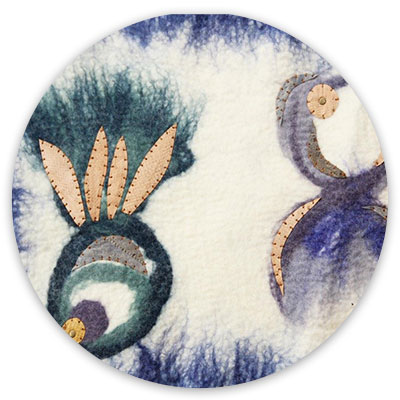Sustainability strategies: experimentation with Patagonian fish leather in apparel and textile design
DOI:
https://doi.org/10.24310/Idiseno.2022.v17i.13143Keywords:
Sustainability – Sustainable design – Clothing and textile design – Public politics – Cooperative workAbstract
This article aims to analyze the issue of sustainability in clothing and textile design. To do this, a collective project is tackled between the Municipality of Quilmes and the Province of Chubut, based on the design of garments and accessories, based on experimentation with Patagonian fish leather.
In 2013, within the framework of the Market of Cultural Industries of Argentina (MICA), the coordinators of the project "Towards a comprehensive use of catches: tanning of fish skins and making clothing, footwear and accessories", promoted by the Chubut Fisheries Secretariat, they contacted the heads of the Operational Directorate of Cultural Industries of the Municipality of Quilmes. The objective of this joint work was to apply Patagonian fish leather in products developed by Quilmeño designers, in order to avoid the generation of waste and environmental pollution produced by its disposal.
From a qualitative approach, based on the technique of interviews, and the survey of secondary sources, this article analyzes the sustainability criteria supported by these public policies, the benefits and limits that the manufacture of sustainable products entails, as well as cooperative work between designers, artisans and public officials.
Downloads
Metrics
Publication Facts
Reviewer profiles N/A
Author statements
Indexed in
-
—
- Academic society
- N/A
- Publisher
- Universidad de Málaga
References
Alatsis G. (2019). «El rol de los intermediarios culturales en la producción de la ´creencia colectiva´: la conformación de un circuito de diseño en Quilmes». Cuadernos del Centro de Estudios en Diseño y Comunicación [Ensayos], 21 (88), [177-192].
Becker, H. (2008). Los mundos del arte. Sociología del trabajo artístico. Bernal: Universidad Nacional de Quilmes.
Bony, A. (2008). Le design. Paris: Larousse.
Correa, m. E. (2017). «Diseño y sustentabilidad. Un nuevo escenario posible en el campo de la moda». Cuadernos del Centro de Estudios en Diseño y Comunicación [Ensayos], 20 (76), [89-104].
Denzin, N. K. y Lincoln, Y. (Eds.) (1994). Handbook of Qualitative Research. California: Sage.
Díaz, V. (2017). «La construcción de valor en el diseño de indumentaria argentino a partir de la inclusión de producción artesanal de pueblos originarios y rurales.
Perspectivas de una investigación en curso». Trabajo presentado en XII Jornadas de Sociología de la Facultad de Ciencias Sociales de la Universidad de Buenos Aires, Argentina.
Duarte Poblete, S. y Núñez García, R. (2020). «Materiales biológicos. Materiales y sustentabilidad a través del diseño». Tableros. N. 11. Facultad de Artes. Universidad Nacional de La Plata. Disponible en: http://papelcosido.fba.unlp.edu.ar/ojs/index.php/tableros/article/view/1159/1402
Entwistle, J. (2014). Sustainability and Fashion. En Fletcher, K. y Tham, M. (Eds.), The Routledge Handbook of Sustainability and Fashion. Londres: Routledge. (capítulo 2, pp. 25-32).
Frisa, M. L. (2020). Las formas de la moda. Cultura, industria, mercado. Buenos Aires: Ampersand.
Gardetti, M. A. (2017). Textiles y moda. ¿Qué es ser sustentable?. Buenos Aires: LID Editorial Empresarial.
Guasch Sastre, C. (2021). «How materials can shape our future?». En Clèrries, L., Rognoli, V., Solanki, S., Llorach, P. (Eds.) Material designers: boosting talent towards circular economies. Disponible online: http://materialdesigners.org/wp-content/uploads/2021/03/MaDe-Book-1.pdf
Mené, R. E. (2021). «Biomaterialidad como alternativa al esteticismo productivista». A y P continuidad. Dossier: Diseño industrial en Latinoamérica: continuidades, quiebres y desafíos, N.15/8, [76-83].
Salcedo, E. (2014). Moda ética para un futuro sostenible. Barcelona: Gustavo Gili.
Saulquin, S. (2014). Política de las apariencias: nueva significación del vestir en el contexto contemporáneo. Buenos Aires: Paidós.
Sennet, R. (2013). Artesanía, tecnología y nuevas formas de trabajo. Madrid: Katz Editores.
The Ellen MacArthur Foundation. «What is a circular economy?» Disponible en: https://ellenmacarthurfoundation.org/ https://ellenmacarthurfoundation.org/topics/circular-economy-introduction/overview
Wolf, B. (2008). «Diseño sustentable». En Fernández, S. y Bonsiepe, G. (Coords.), Historia del diseño en América Latina y el Caribe. Industrialización y comunicación visual para la autonomía. San Pablo: Editora Blücher. (pp. 324-333)
Zito, M. (2014). «La ética del diseño sustentable». Cuadernos del Centro de Estudios en Diseño y Comunicación [Ensayos], 14 (48), [95-105].

Downloads
Published
How to Cite
Issue
Section
License
Aquellos autores/as que tengan publicaciones con esta revista, aceptan los términos siguientes:- Los autores/as conservarán sus derechos de autor y garantizarán a la revista el derecho de primera publicación de su obra, el cuál estará simultáneamente sujeto a la Licencia de reconocimiento de Creative Commons que permite a terceros compartir la obra siempre que se indique su autor y su primera publicación esta revista.
- Los autores/as podrán adoptar otros acuerdos de licencia no exclusiva de distribución de la versión de la obra publicada (p. ej.: depositarla en un archivo telemático institucional o publicarla en un volumen monográfico) siempre que se indique la publicación inicial en esta revista.
- Se permite y recomienda a los autores/as difundir su obra a través de Internet (p. ej.: en archivos telemáticos institucionales o en su página web) antes y durante el proceso de envío, lo cual puede producir intercambios interesantes y aumentar las citas de la obra publicada. (Véase El efecto del acceso abierto).







14.png)



